Our strength is fiber, or Powered Fiber Cable System
Modern network infrastructures are constantly expanding, becoming more and more versatile and complex. Wi-Fi access points, video surveillance cameras, elements of building automation and control systems - more and more various devices are connected to networks. As new devices are added, the cable infrastructure necessary for their connection is also developing, and the possibility of organizing their power supply via SCS is becoming more and more attractive.
Power over the wired Ethernet (PoE) network is a great technology that is used to connect an ever wider range of devices. According to various sources, more than 100 million nodes worldwide use PoE in total. And this technology is constantly evolving.
The first PoE standard, IEEE 802.3af, adopted by the IEEE organization in 2003, limited the technology to only 15 W at the PSE (Power Source Equipment) device level. Since losses are inevitable during transmission, when using IEEE 802.3af systems, only 13 W reach the devices that are powered (Powered Device, PD).
No sooner did the IEEE institute accept this standard, as the growing demand for PoE applications with more power led to the start of work on updating it. The new IEEE 802.3at standard (also called PoE +) was ratified in 2009. With its adoption, PSE equipment could supply up to 30 watts to the network. Accordingly, the power of PD powered devices increased to 25.5 watts. Like PoE IEEE 802.3af systems, PoE + technical solutions use two of four pairs of standard SCS cable to supply voltage.
')
To further increase capacity, in May 2013, a special group was formed by the IEEE 802.3 committee to study the issue of standardization of PoE technology, which would use all four pairs of cabling. Upon completion of its work in November 2013, the IEEE Institute formed the IEEE 802.3bt Working Group, which is tasked with developing a 4-pair PoE standard. For 2018, it is scheduled to ratify the PoE IEEE 802.3bt standard, which raises the power (at PSE level) to 90 watts.
Along with the standard, non-standard (proprietary) PoE variants are actively developing. An example of this technology is Cisco Universal PoE (UPoE), which extends the capabilities of IEEE 802.3af PoE + to support 60 watts per port.
Remote PoE power technologies have many advantages. This means lower installation costs (since the power supply uses the same wiring as for information transfer), and improved control of devices for more efficient control, and the use of a centralized UPS for reliable and fail-safe operation of end devices. In general, combining the functions of power supply and information transmission in a single cable system simplifies the implementation of a universal “intelligent” infrastructure. However, PoE has one serious drawback: the range is limited by the “range” of the Ethernet twisted links - only 100 m. And how often do you have tasks to connect more distant objects via PoE ...
CommScope offers to solve these problems using the Powered Fiber Cable System. Such a system consists of three main elements:

Schematic diagram of the PFCS system
The hybrid cable consists of optical fibers (for information transfer) and copper wires (for power supply). It has a simple modular design, is convenient in laying and cutting, does not require the use of special tools. The cable is available with both single-mode and multi-mode fiber - support for one type of fiber or another is determined by the choice of the SFP module, which is installed in the PoE Extender.
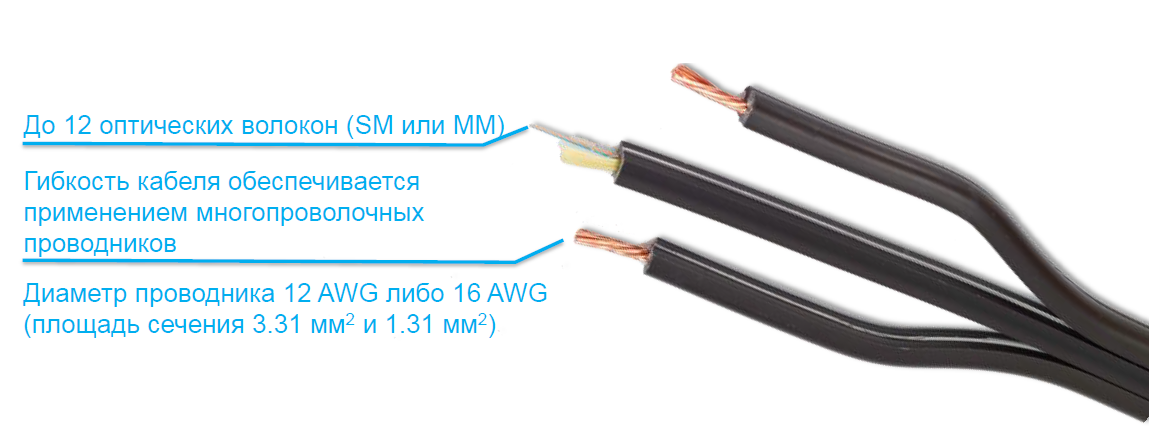
PFCS hybrid cable
Widely used fasteners for flat cables used in FTTx installations are suitable for cable fasteners. The cable is available in versions for external installation (PE sheath) and universal (LSZH sheath).
At the far end, such a cable is terminated by a special PoE Extender extension device, which provides a change in the information transmission medium (optical-to-copper converter) and the necessary power conversion. A hybrid cable is connected to the input of this compact device, and a standard RJ-45 interface with PoE support is connected to its output. Through an extension cord, end devices that receive power over PoE can be connected via a conventional twisted pair cable.

Appearance Single PoE Extender
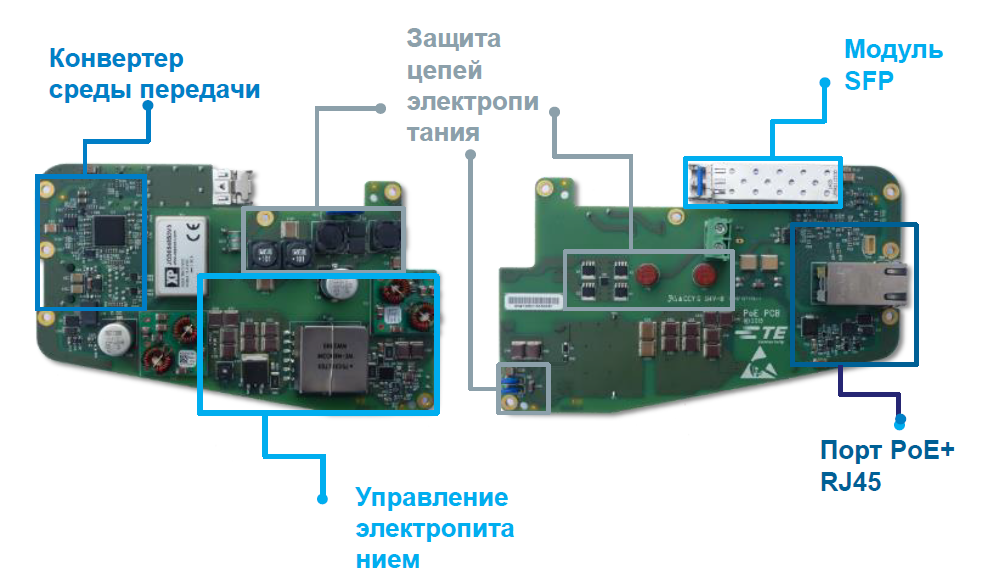
Internal filling PoE Extender
The maximum range of the Powered Fiber Cable System when connecting PoE devices (power up to 15 W) is 3 km. When the power is increased to 30 W (for PoE + devices), the maximum range is approximately halved. The PoE Extender itself can be installed on the street - IP67 degree of dust protection. In addition to converting the information signal transmission medium, it provides power management. It incorporates several levels of electrical protection, including voltage spikes (for example, when lightning strikes), fluctuations of the electromagnetic field and voltage.
CommScope offers both single and dual port extenders. The latter can be connected, including two PoE + devices that consume up to 30 watts each.
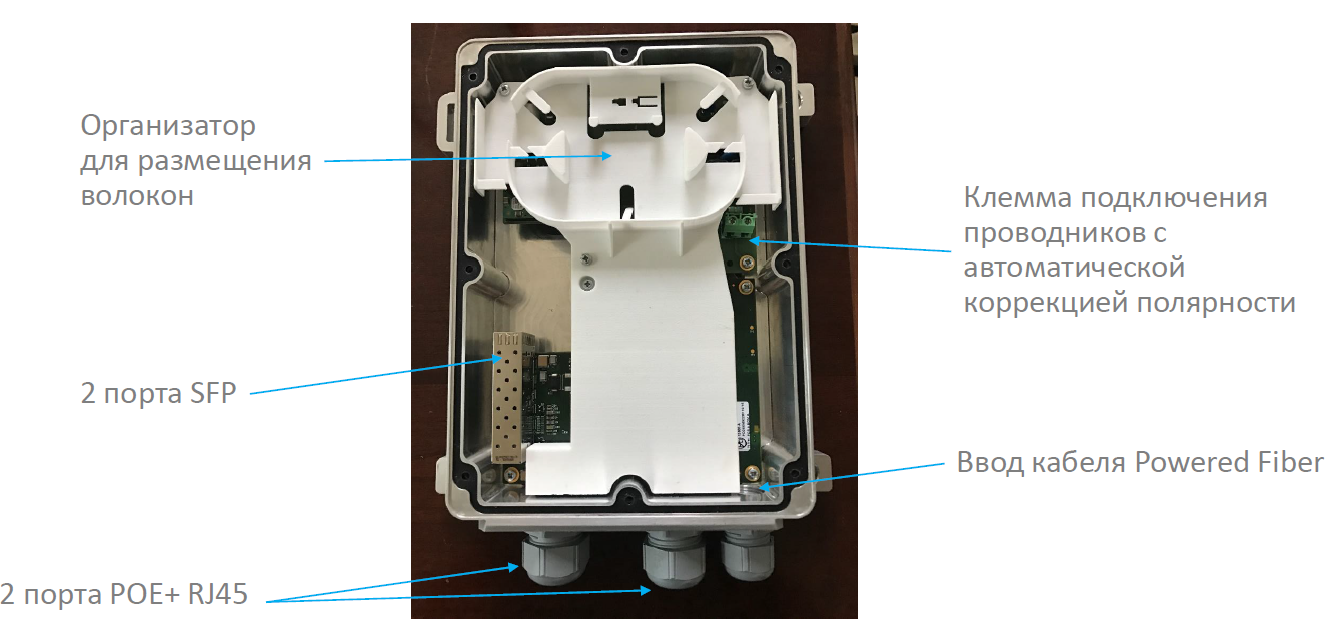
Dual Port PoE Extender
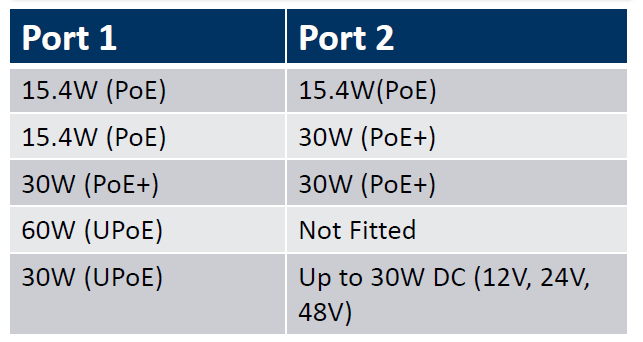
Modes of operation of its ports
The new products of the Powered Fiber Cable System are extensions that support power up to 60 W (UPoE technology). (60W support is possible in a dual-port extension, but then the second port is not used). Such power is often required for the operation of HD video cameras with a heating element and other devices with increased power consumption. CommScope products support a power supply of 60 W for a distance of up to 650 m. Given the 100 m path between the extension cord and the network device, the maximum range reaches 750 m.
One of the many benefits of using Powered Fiber Cable System is the centralization of the main elements of the power supply system. UPS and other power supplies are placed in a well-protected central area, which increases the overall reliability and safety of the system. You can place the connected devices exactly where it is optimal from the point of view of the tasks it performs, without being tied to electrical outlets.
There are many scenarios for using the Powered Fiber Cable System.
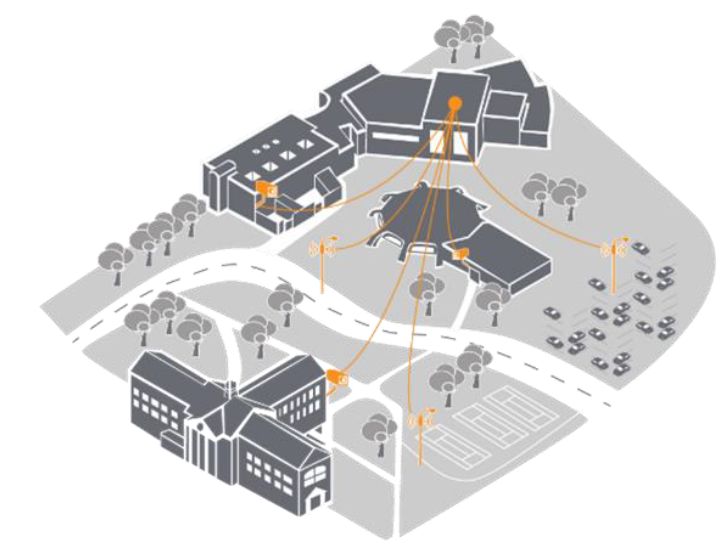
For example, in the classical campus network, it can be used to connect video cameras (including on lighting poles), Wi-Fi access points, micro-cells to improve the coverage of cellular networks and other equipment. A universal hybrid cable with an LSZH sheath can be routed around the premises, and then along external routes (without additional couplings). The power supply, as well as the backup power supply system (UPS), is located in the communication center or in the data center.

The Powered Fiber Cable System will also be extremely useful for mobile operators, who can use it to connect devices located near base stations. These can be the same surveillance cameras, Wi-Fi access points, micro-cells. The power supply is conveniently located at the location of the base station itself.
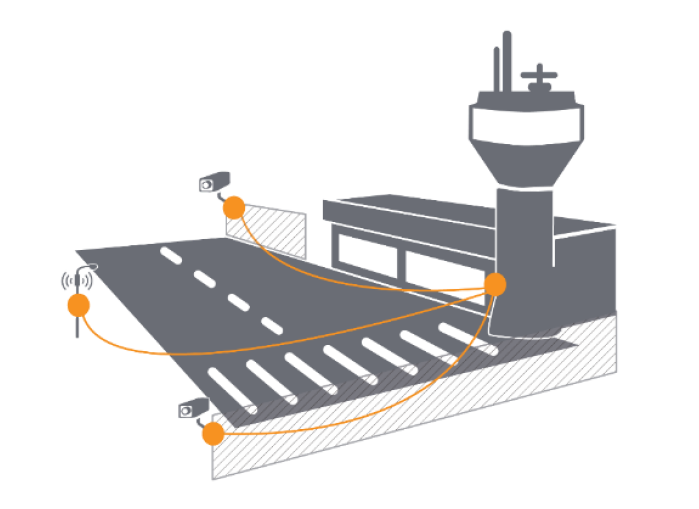
Another example is the organization of a video surveillance system at an airport. In addition to video cameras, the Powered Fiber Cable System can also provide external Wi-Fi access points that are used to organize closed airport networks. The use of cable for external installation (PE sheath) expands the possibilities of laying, including the use of cable ducts and direct laying into the ground.
And these are just some examples of the application of the Powered Fiber Cable System. Increasing the “range” of the PoE technology up to 3 km, it allows placing devices without binding to the power supply network where they are required.
Power over the wired Ethernet (PoE) network is a great technology that is used to connect an ever wider range of devices. According to various sources, more than 100 million nodes worldwide use PoE in total. And this technology is constantly evolving.
The first PoE standard, IEEE 802.3af, adopted by the IEEE organization in 2003, limited the technology to only 15 W at the PSE (Power Source Equipment) device level. Since losses are inevitable during transmission, when using IEEE 802.3af systems, only 13 W reach the devices that are powered (Powered Device, PD).
No sooner did the IEEE institute accept this standard, as the growing demand for PoE applications with more power led to the start of work on updating it. The new IEEE 802.3at standard (also called PoE +) was ratified in 2009. With its adoption, PSE equipment could supply up to 30 watts to the network. Accordingly, the power of PD powered devices increased to 25.5 watts. Like PoE IEEE 802.3af systems, PoE + technical solutions use two of four pairs of standard SCS cable to supply voltage.
')
To further increase capacity, in May 2013, a special group was formed by the IEEE 802.3 committee to study the issue of standardization of PoE technology, which would use all four pairs of cabling. Upon completion of its work in November 2013, the IEEE Institute formed the IEEE 802.3bt Working Group, which is tasked with developing a 4-pair PoE standard. For 2018, it is scheduled to ratify the PoE IEEE 802.3bt standard, which raises the power (at PSE level) to 90 watts.
Along with the standard, non-standard (proprietary) PoE variants are actively developing. An example of this technology is Cisco Universal PoE (UPoE), which extends the capabilities of IEEE 802.3af PoE + to support 60 watts per port.
Remote PoE power technologies have many advantages. This means lower installation costs (since the power supply uses the same wiring as for information transfer), and improved control of devices for more efficient control, and the use of a centralized UPS for reliable and fail-safe operation of end devices. In general, combining the functions of power supply and information transmission in a single cable system simplifies the implementation of a universal “intelligent” infrastructure. However, PoE has one serious drawback: the range is limited by the “range” of the Ethernet twisted links - only 100 m. And how often do you have tasks to connect more distant objects via PoE ...
CommScope offers to solve these problems using the Powered Fiber Cable System. Such a system consists of three main elements:
- Power Supply Unit (PSU)
- Hybrid cable
- Extender device PoE Extender

Schematic diagram of the PFCS system
The hybrid cable consists of optical fibers (for information transfer) and copper wires (for power supply). It has a simple modular design, is convenient in laying and cutting, does not require the use of special tools. The cable is available with both single-mode and multi-mode fiber - support for one type of fiber or another is determined by the choice of the SFP module, which is installed in the PoE Extender.

PFCS hybrid cable
Widely used fasteners for flat cables used in FTTx installations are suitable for cable fasteners. The cable is available in versions for external installation (PE sheath) and universal (LSZH sheath).
At the far end, such a cable is terminated by a special PoE Extender extension device, which provides a change in the information transmission medium (optical-to-copper converter) and the necessary power conversion. A hybrid cable is connected to the input of this compact device, and a standard RJ-45 interface with PoE support is connected to its output. Through an extension cord, end devices that receive power over PoE can be connected via a conventional twisted pair cable.

Appearance Single PoE Extender

Internal filling PoE Extender
The maximum range of the Powered Fiber Cable System when connecting PoE devices (power up to 15 W) is 3 km. When the power is increased to 30 W (for PoE + devices), the maximum range is approximately halved. The PoE Extender itself can be installed on the street - IP67 degree of dust protection. In addition to converting the information signal transmission medium, it provides power management. It incorporates several levels of electrical protection, including voltage spikes (for example, when lightning strikes), fluctuations of the electromagnetic field and voltage.
CommScope offers both single and dual port extenders. The latter can be connected, including two PoE + devices that consume up to 30 watts each.

Dual Port PoE Extender

Modes of operation of its ports
The new products of the Powered Fiber Cable System are extensions that support power up to 60 W (UPoE technology). (60W support is possible in a dual-port extension, but then the second port is not used). Such power is often required for the operation of HD video cameras with a heating element and other devices with increased power consumption. CommScope products support a power supply of 60 W for a distance of up to 650 m. Given the 100 m path between the extension cord and the network device, the maximum range reaches 750 m.
One of the many benefits of using Powered Fiber Cable System is the centralization of the main elements of the power supply system. UPS and other power supplies are placed in a well-protected central area, which increases the overall reliability and safety of the system. You can place the connected devices exactly where it is optimal from the point of view of the tasks it performs, without being tied to electrical outlets.
There are many scenarios for using the Powered Fiber Cable System.

For example, in the classical campus network, it can be used to connect video cameras (including on lighting poles), Wi-Fi access points, micro-cells to improve the coverage of cellular networks and other equipment. A universal hybrid cable with an LSZH sheath can be routed around the premises, and then along external routes (without additional couplings). The power supply, as well as the backup power supply system (UPS), is located in the communication center or in the data center.

The Powered Fiber Cable System will also be extremely useful for mobile operators, who can use it to connect devices located near base stations. These can be the same surveillance cameras, Wi-Fi access points, micro-cells. The power supply is conveniently located at the location of the base station itself.

Another example is the organization of a video surveillance system at an airport. In addition to video cameras, the Powered Fiber Cable System can also provide external Wi-Fi access points that are used to organize closed airport networks. The use of cable for external installation (PE sheath) expands the possibilities of laying, including the use of cable ducts and direct laying into the ground.
And these are just some examples of the application of the Powered Fiber Cable System. Increasing the “range” of the PoE technology up to 3 km, it allows placing devices without binding to the power supply network where they are required.
Source: https://habr.com/ru/post/349568/
All Articles